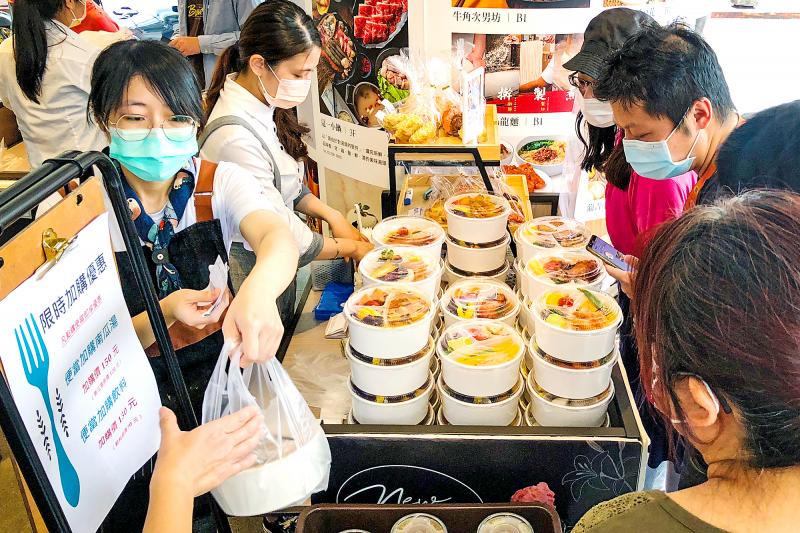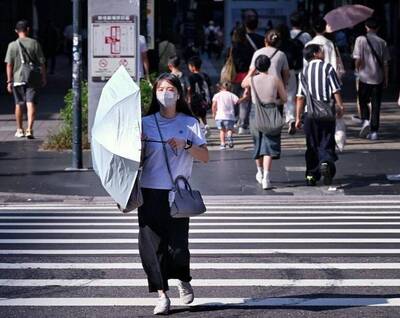After more than a month relying only on takeout and delivery orders, restaurants are finding there is a lot more to staying competitive than boxing up meals, as consumer demands for better quality and transparency are likely to stay.
The ban on indoor dining last month, along with a level 3 COVID-19 alert, has forced food vendors to adapt fast.
New consumer habits are reflected in data from mobile point-of-sale provider iCHEF, which reported that takeout and delivery sales accounted for more than 70 percent of total revenue in the first three weeks of the alert.

Photo: CNA
On the other hand, on-site takeout orders were down more than 60 percent compared with a single week in April, the firm said, even as online takeout orders quadrupled by the third week.
Ministry of Economic Affairs data support this trend, with the number of food and drink vendors offering delivery rising from 40.1 percent in 2018 to 59 percent this year.
However, iCHEF said that despite the 40 percent surge in delivery sales, overall growth has stagnated due to capacity limitations and consumer budgeting.
The surge in online takeout orders makes certain trends clear, iCHEF cofounder Ken Chen (程開佑) said.
“The peace of mind that comes with no interactions, no waiting, no contact and no on-site payment is what consumers need these days,” he said.
At the same time, total turnover has fallen about 60 percent, he added.
A look at complaints online, ranging from undercooked rice to ordering system glitches and defrosted meat, exposes just how far restaurants have to go to fulfill these unexpected new demands.
Everyone was caught by surprise by this COVID-19 outbreak “landslide,” food blogger Fei Chi (費奇) said.
Many restaurants are earning only 20 to 30 percent of what they did before, with only one-third of the staff, she said.
Without chefs or sufficient ingredients as supply is squeezed, food quality would also suffer, she said.
Restaurants can only hope that the public affords some concessions, but that does not exempt them from owning up to their customers’ complaints, Fei added.
“Dishes for takeout and delivery are made to order, just like dine-in, but the delivery process, time and containers can have a huge impact,” said Tsai Ping-cheng (蔡秉錚), assistant manager of cuisine for Tai Tong Food & Beverage Group, which operates hundreds of chain restaurants natiowide.
Packing a meal for takeout is not just a matter of placing food in a box, Tsai said.
Packaging must be designed so that each element keeps its flavor, stays warm and does not leak, all of which takes time, he said.
In the US, which has been facing new realities caused by the COVID-19 pandemic for more than a year, 100,000 restaurants were forced to close, putting 2 million people out of work, Fei said.
There would be a similar wave of closures if lockdown measures continue in Taiwan, she added.
Operators must adapt to survive, such as by offering filling budget options, she said, giving as an example the spaghetti meals offered by some Michelin-starred restaurants.
She said that restaurants with large amounts of stored food, such as all-you-can-eat establishments and large chains, could also offload their excess ingredients by selling them directly to consumers.
Chain restaurant executives have instead turned their sights to subscription models, which they hope will generate long-term brand loyalty and — more importantly — stable income.
They also see business opportunities in health foods, as well as new menus offering upscale and holiday options.
Even after the pandemic, Fei expects certain changes to last.
“Food miles” would once again fall under scrutiny, as consumers want to know how far their food has had to travel to reach them, which directly equates with risk of contamination, she said.
Similarly, chefs would prefer to keep using local ingredients, remembering how hard it was to find imported goods, such as white asparagus, when borders were closed, Fei said.
The pursuit of healthier food would also lend to lasting demand for natural “raw” ingredients, she added.
The pandemic would serve as a Darwinian test of survival, Fei said.
Establishments boosted by pandemic measures would be small local spots with cheaper prices, not large chains, she said, conceding that major brands boasting better reputations could make it through.
Newer establishments that rely on scarcity tactics would struggle to stay afloat, she added.
Lastly, the pandemic would increase demand for transparency with regard to food sources and cooking methods, although whether this would correspond with an increase in prices remains to be seen, Fei said.

Three Taiwanese airlines have prohibited passengers from packing Bluetooth earbuds and their charger cases in checked luggage. EVA Air and Uni Air said that Bluetooth earbuds and charger cases are categorized as portable electronic devices, which should be switched off if they are placed in checked luggage based on international aviation safety regulations. They must not be in standby or sleep mode. However, as charging would continue when earbuds are placed in the charger cases, which would contravene international aviation regulations, their cases must be carried as hand luggage, they said. Tigerair Taiwan said that earbud charger cases are equipped

Foreign travelers entering Taiwan on a short layover via Taiwan Taoyuan International Airport are receiving NT$600 gift vouchers from yesterday, the Tourism Administration said, adding that it hopes the incentive would boost tourism consumption at the airport. The program, which allows travelers holding non-Taiwan passports who enter the country during a layover of up to 24 hours to claim a voucher, aims to promote attractions at the airport, the agency said in a statement on Friday. To participate, travelers must sign up on the campaign Web site, the agency said. They can then present their passport and boarding pass for their connecting international

Taiwan sweltered through its hottest October on record, the Central Weather Administration (CWA) said yesterday, the latest in a string of global temperature records. The main island endured its highest average temperature since 1950, CWA forecaster Liu Pei-teng said. Temperatures the world over have soared in recent years as human-induced climate change contributes to ever more erratic weather patterns. Taiwan’s average temperature was 27.381°C as of Thursday, Liu said. Liu said the average could slip 0.1°C by the end of yesterday, but it would still be higher than the previous record of 27.009°C in 2016. "The temperature only started lowering around Oct. 18 or 19

WEATHER Typhoon forming: CWA A tropical depression is expected to form into a typhoon as early as today, the Central Weather Administration (CWA) said yesterday, adding that the storm’s path remains uncertain. Before the weekend, it would move toward the Philippines, the agency said. Some time around Monday next week, it might reach a turning point, either veering north toward waters east of Taiwan or continuing westward across the Philippines, the CWA said. Meanwhile, the eye of Typhoon Kalmaegi was 1,310km south-southeast of Oluanpi (鵝鑾鼻), Taiwan’s southernmost point, as of 2am yesterday, it said. The storm is forecast to move through central